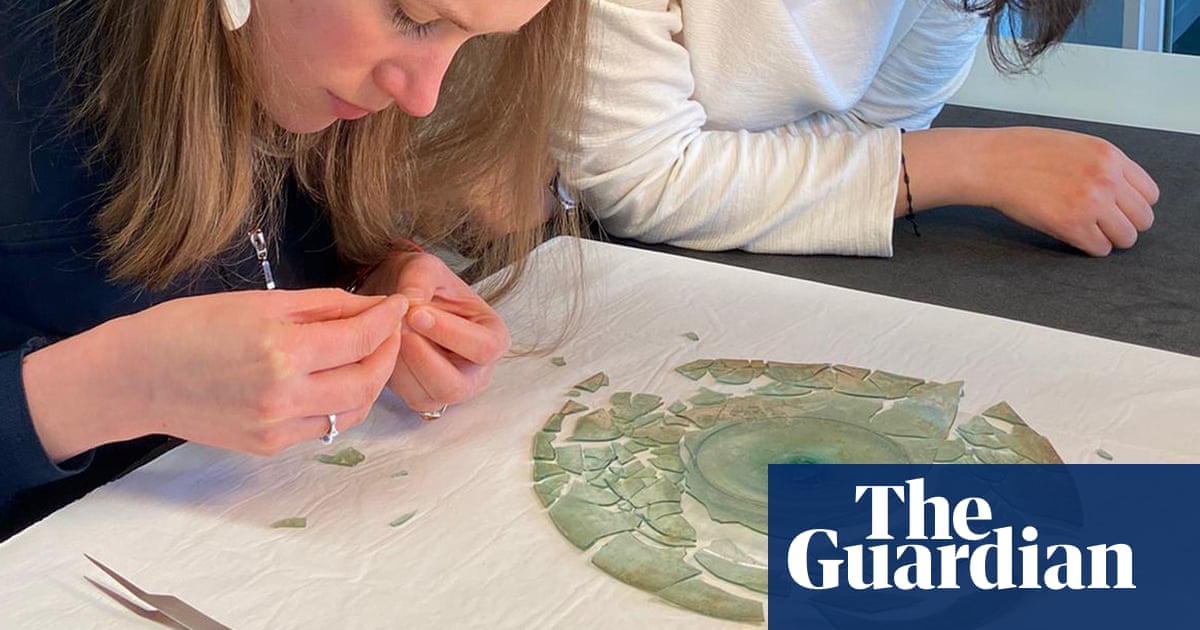
Show caption A team of experts reassembled hundreds of pieces of glass. Photograph: The Trustees of the British Museum the American University of Beirut/PA British Museum Ancient glass vessels restored after Beirut blast go on display at British Museum Eight objects from Roman, Byzantine and Islamic periods were shattered in port explosion two years ago Nadeem Badshah Sat 27 Aug 2022 21.23 BST Share on Facebook
Share on Twitter
Share via Email
Restored ancient glass vessels that were damaged in the Beirut port explosion two years ago have gone on display at the British Museum.
The eight objects, from the Roman, Byzantine and Islamic periods, have been pieced back together by museum conservation experts and are being showcased at the London venue until October before being returned to Lebanon.
The artefacts are among the precious items to have been saved in an emergency recovery campaign that was launched after the American University in Beirut (AUB) Museum was heavily damaged in the disaster that killed at least 218 people, wounded 7,000 and displaced 300,000 people in August 2020.
The vessels were among 74 items from the Roman, Byzantine and Islamic periods in a case at the AUB that fell over after being hit by the shockwave of the explosion, which occurred 2 miles (3km) away after a massive stockpile of ammonium nitrate exploded.
The blast hit the building and smashed the glass objects inside the case.
The British Museum’s director, Hartwig Fischer, said the items – which are on show in an event called Shattered glass Of Beirut at the Asahi Shimbun Displays – “tells a story of near destruction and recovery, of resilience and collaboration”.
Hidde van Seggelen, president of the European Fine Art Foundation (Tefaf), said: “We are immensely gratified to see the restoration of these ancient glass objects come to fruition.”
“Bringing these pieces back to their rightful form has been a compelling symbol of resilience and we are honoured to have been part of this important collaboration,” he added.
A team of experts carefully reassembled hundreds of fragments of glass and the vessels have been repaired so they are structurally sound, although the breakage marks can still be seen.
Dr Nadine Panayot, curator of the AUB Archaeological Museum, said: “Reconstructing these fragmented glass vessels one tiny bit at a time, helped to reunite, to recognise their heritage value, and to build a sense of community.
“To see these shattered and delicate vessels reassembled not only sparked a healing process, but also inspired me to hope for a better future.”
The British Museum said the vessels that have been conserved at the London site are hugely important in telling the story of the development of glass-blowing technology in Lebanon in the first century BC, a period in which glass production was revolutionised.
Last month, the deputy director of the British Museum proposed a Parthenon partnership with Greece that could see the marbles returned to Athens after more than 200 years.
The sculptures – 17 figures and part of a frieze that decorated the 2,500-year-old Parthenon temple on the Acropolis – were taken by Lord Elgin in the early 19th century when he was the British ambassador to the Ottoman empire, and have since been the subject of a long-running dispute over where they should be displayed.
In an interview with the Sunday Times Culture magazine, Jonathan Williams said the British Museum wanted to “change the temperature of the debate” around the marbles.
Williams said: “What we are calling for is an active ‘Parthenon partnership’ with our friends and colleagues in Greece. I firmly believe there is space for a really dynamic and positive conversation within which new ways of working together can be found.”







